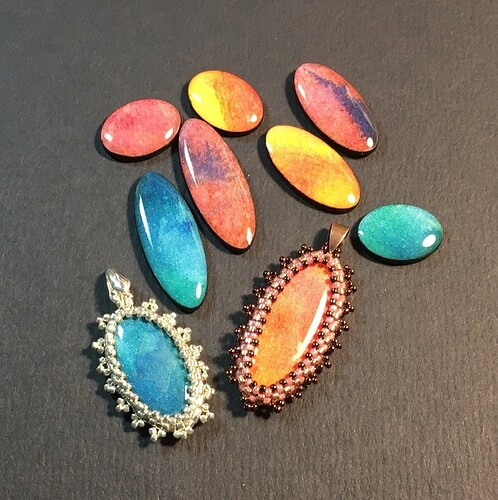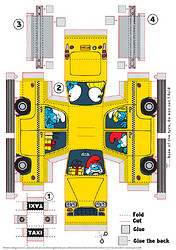I felt like doing some beaded bezeling, but didn’t have any cabochons in the sizes I wanted, so I watercolor painted up some Canson Watercolor Artboard, laser cut various cab shapes, and domed them with resin before beading the bezels.
sigh. Awesome.
Wow! Beautiful!
Zowee! Love these…my favorites are the turquoise colored ones. You have this process down pat…nice work.
Instant doublets! very pretty.
Triplets, if you count the watercolor as a layer. 
Wow… I didn’t understand most of those words… (not an artist…) but those look absolutely amazing!
What is the size of them?
(And when you say “resin” is this the same resin used for a 3D-printer that uses “resin”?)
A cabochon is a gemstone that has been polished in a rounded manner (like a turquoise) rather than faceted (like a diamond).
A bezel is the (usually metal) edge strip that goes around the cab to hold it on to the back bit. Bezeling with beads is a fun alternative to using metal.
Canson Watercolor Artboard is a roughly 1/16” thick board with watercolor paper bonded on one side. The heavy backing helps the paper resist curling when it gets wet.
The type of resin used in 3D printers is UV-cured, and I have tried that type for this kind of project, but I’ve found that it’s very picky about the substrate it’s on, and tends to peel off due to incomplete curing at the mating surface. What I used on these pieces was a 2-part epoxy that you mix and apply, then wait 24 hrs to cure completely. The brand I used was Little Windows resin, which does the best job of doming on a surface compared to others I’ve tried.
Oh, and the size of the longest one is about 1.5” x 0.5”
That was a wonderful explanation!
Thanks for taking the time to enlighten me!
In lapidary a doublet is a colorful mineral like opal, where the mineral is too thin to cut into a cabochon shape so another clear mineral like quartz is bonded to the color layer and then cut into a cab. Opal is also sometimes made into a triplet where the color layer (the “fire”) is almost transparent unless it is backed with a black mineral like jet, and then a clear like quartz on top.
The effect can be replicated with plastic and glass in inexpensive costume jewelry.
These are gorgeous, @cynd11! Amazing what you can do. The shades of blue/teal are my favorite too.
Wow! Fantastic as usual. Didn’t Know the cabochon vs facet stuff! Interesting. Must focus…
Often the material with “fire” is as thin as watercolor paper but backing with dark material always enhances the color. Back in the day when I was cutting my own Mexican Opals, instead of the dop wax that needed to be softened with heat that does a terrible thing to opals, I used epoxy with charcoal powder mixed in and cut the opal from the other side. After the opal would be cut from its stick and the epoxy form the back side, This solved a lot of problems of needing a flat back and the epoxy provided strength to hold the stone together.
Apparently there is an Australian form of opal that the material is quite blue but has little fire. I had some that had a lot of fire for the type but would be considered very little otherwise, but it was a very nice powder blue so I really liked it, with fire not the point.
There are apparently other pieces much darker blue that all the triplets I had used, and every so often had a flash of opal color, but apparently it was called "potch"opal and not considered useful for other than that. The tops were all quartz as it is far more scratch resistant.
Man, I loved cutting opal, I must have cut pounds of the Aussie stuff. By the time you cut it into shape each stone was a surprise that only started revealing itself once you approached the polish. I hated Dop wax. My sticks were large nails that I ground the head flat and used a small amount of superglue to affix the stone. To remove it put the nail in a vise and hit the shank (well below the opal) for a couple of seconds with a torch while putting a slight pressure on the stone with my fingers and it pops right off. Never had a problem with that method.
I’d wager you and I could finish more than a few beers before we ran out of things to talk about.
I used dop wax on something like these for most work…
https://www.amazon.com/Block-55-Wooden-Pegboard-Pegs/dp/B01H5L9M1E
Most excellent for moving the back in a circle…
I have some of these in green that I got from the Tokyo Automotive museum…technically the kids got it for collecting stamps around the museum…but somehow I ended up with the paper cars. I learned a lot in this post…but at the same time I am not sure I learned anything, since all this opal cutting stuff is way over my head. You guys need to start a hands on workshop so I can learn. 

I have always been thinking that an old tech Makerspace, with pottery, metalsmithing, stone cutting/carving, glassblowing, casting, etc. would be a fabulous project, and with a marketing plan, create one of those situations you see where the output of anything is famous for that alone.
The makerspace my kids take classes has started blacksmithing classes. I always wanted to learn glassblowing, weaving, basketmaking. Actually, I have a ton of things I want to learn, something that I can do with my hands, and not having to learn a new computer program.
Beautiful work!! Wow, you have an incredible skill set!

